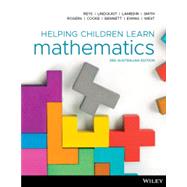
Note: Supplemental materials are not guaranteed with Rental or Used book purchases.
Purchase Benefits
What is included with this book?
Chapter 1 School mathematics in a changing world 1
Introduction 2
1.1 What is mathematics? 3
1.2 What determines the mathematics being taught? 4
1.3 Where can you turn? 12
Chapter 2 Helping children learn mathematics with understanding 20
Introduction 21
2.1 How can we support the diverse learners in our classrooms? 21
2.2 Meaningful connections between procedural and conceptual knowledge 27
2.3 How do children learn mathematics? 29
2.4 How can we help children make sense of mathematics? 34
Chapter 3 Planning and teaching 50
Introduction 51
3.1 Effective planning and preparation for teaching: Using strategic questions to inform teaching practice 51
3.2 Planning for effective teaching 66
3.3 Levels of planning 67
3.4 Planning different types of lessons 68
3.5 Meeting the needs of all students 75
3.6 Assessment and analysis in planning 80
Chapter 4 Enhancing learning and teaching through assessment and feedback 87
Introduction 88
4.1 Enhancing learning and teaching 89
4.2 Gathering information on student learning 92
4.3 Ways to assess students’ learning and dispositions 94
4.4 Keeping records and communicating about assessments 109
Chapter 5 Processes of doing mathematics 121
Introduction 122
5.1 Understanding 123
5.2 Fluency 124
5.3 Problem solving 125
5.4 Reasoning and proof 129
5.5 Communication 134
5.6 Connections 135
5.7 Representations 138
Chapter 6 Helping children with problem solving 148
Introduction 149
6.1 What is a problem and what is problem solving? 150
6.2 Teaching mathematics through problem solving 151
6.3 Strategies for problem solving 162
6.4 The importance of looking back 170
6.5 Helping all students with problem solving 172
Chapter 7 Counting and number sense in early childhood and primary years 181
Introduction 182
7.1 Developing number sense 183
7.2 Counting principles 197
7.3 Counting strategies 200
7.4 Cardinal, ordinal and nominal numbers 210
7.5 Writing numerals 211
Chapter 8 Extending number sense: Place value 220
Introduction 221
8.1 Our numeration system 223
8.2 Nature of place value 224
8.3 Beginning place value 231
8.4 Consolidating place value 234
8.5 Extending place value 241
8.6 Reading and writing numbers 247
8.7 Rounding 251
Chapter 9 Operations: Meanings and basic facts 260
Introduction 261
9.1 Helping children develop number sense and computational fluency 263
9.2 Developing meanings for the operations 266
9.3 Mathematical properties 274
9.4 Overview of learning the basic facts 275
9.5 Thinking strategies for basic facts 283
Chapter 10 Mental computation, calculators and estimation 307
Introduction 308
10.1 Calculators 312
10.2 Mental computation 316
10.3 Estimation 323
Chapter 11 Solving problems with written strategies 339
Introduction 340
11.1 Emergent understanding and experiences 342
11.2 Addition 343
11.3 Subtraction 350
11.4 Multiplication 357
11.5 Division 364
11.6 Finding the balance between practice and proficiency 371
Chapter 12 Fractions and decimals: Meanings and operations 380
Introduction 381
12.1 Conceptual development of fractions 383
12.2 Operations with fractions 402
12.3 Conceptual development of decimals 410
12.4 Operations with decimals 414
Chapter 13 Ratio, proportion and percentages: Meanings and applications 423
Introduction 424
13.1 Ratios 426
13.2 Proportions 429
13.3 Percentages 436
Chapter 14 Extending students with number theory 451
Introduction 452
14.1 Number theory in primary school mathematics 452
14.2 Number theory topics for primary school students 458
14.3 Other number theory topics 471
Chapter 15 Pattern and algebraic thinking 482
Introduction 483
15.1 Problems, patterns and relations 485
15.2 Language and symbols of algebra 494
15.3 Modelling, generalising and justifying 496
Chapter 16 Geometry 517
Introduction 518
16.1 The geometry of two-dimensional shapes and three-dimensional objects 521
16.2 Location, position and spatial relationships 545
16.3 Transformations 549
16.4 Visualisation and spatial reasoning 552
Chapter 17 Measurement 560
Introduction 561
17.1 The measurement process 564
17.2 Identifying attributes and comparing 565
17.3 Measurement concepts for all units 578
17.4 Measuring with informal units 581
17.5 Measuring with formal units 584
17.6 Applications including formulae 593
17.7 Comparing and converting measurements 598
17.8 Estimating measurements 600
17.9 Connecting attributes 603
Chapter 18 Data analysis, statistics and probability 613
Introduction 615
18.1 Formulating questions for data collection 618
18.2 Organising and representing data 621
18.3 Analysing data: Descriptive statistics 632
18.4 Interpreting results 639
18.5 Probability 642
Appendix A 658
Appendix B 670
Appendix C 679
Index 707
The New copy of this book will include any supplemental materials advertised. Please check the title of the book to determine if it should include any access cards, study guides, lab manuals, CDs, etc.
The Used, Rental and eBook copies of this book are not guaranteed to include any supplemental materials. Typically, only the book itself is included. This is true even if the title states it includes any access cards, study guides, lab manuals, CDs, etc.